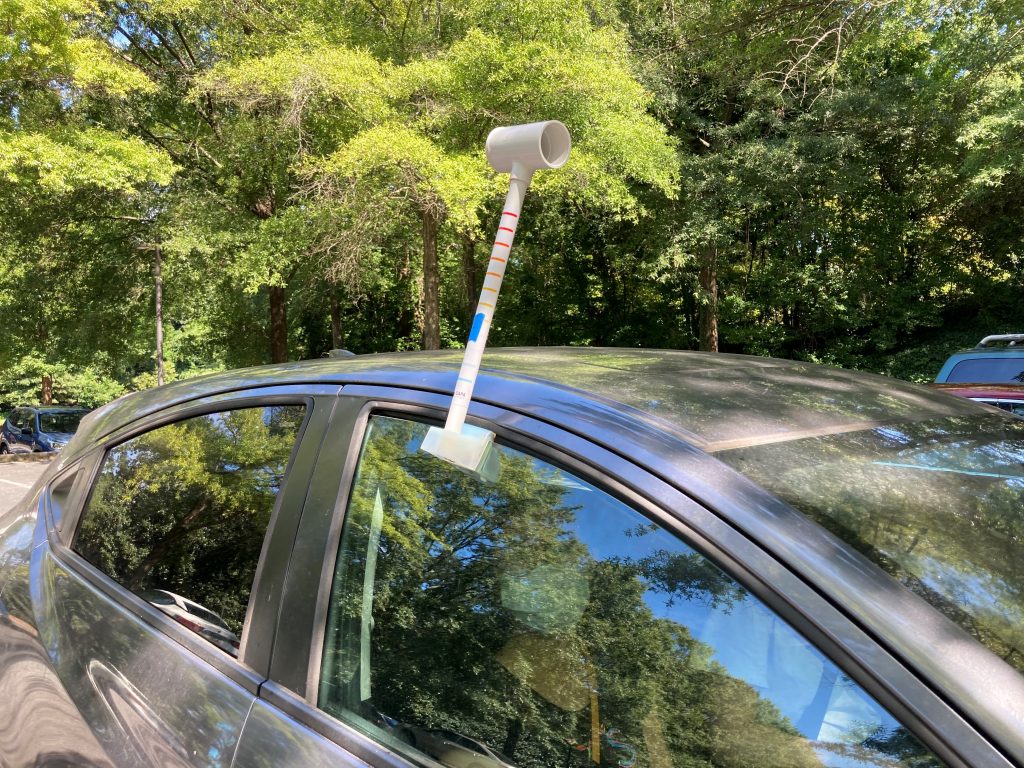Volunteers Drive All Over Atlanta To Study The City’s Heat

Scientists are driving around Atlanta to track the city’s heat and figure out which areas are hottest.
Molly Samuel / WABE
As climate change drives temperatures higher, scientists are working to map Atlanta’s heat, to figure out which areas are hottest and which populations are most at risk.
To help them, this past weekend dozens of volunteers spent hours driving around the city, recording temperatures as they went.
“Science is in motion, y’all,” Taylor Lamb said as she pulled out of a parking lot to begin driving a sensor mounted on her car. “Science is happening.”
Wenting Huang navigated as Lamb drove; they’re both graduate students at Emory’s Rollins School of Public Health. Huang said she got involved because she’d personally experienced the differences between a city’s heat and more rural areas.
“Where I live in China, there’s not this much green land – plants and trees,” she said.

Cities in general are hotter because of all the buildings and the lack of vegetation. This project, and another similar one also happening in Atlanta this summer, are about getting into the details of Atlanta’s urban heat island, and figuring out which areas are the hottest within the already hotter city.
“We want to find the hotspots of temperature in Atlanta to see how climate change and heat waves may impact people,” Guanyu Huang, an environmental health science professor at Spelman College – and no relation to Wenting Huang – said.
The Atlanta Heat Watch Campaign has 12 driving routes and two bike routes, mostly in the City of Atlanta. Volunteers set out across town three different times, to drive each route in the morning, afternoon and evening.
Guanyu Huang, who’s coordinating the project in partnership with other local schools, the National Oceanic and Atmospheric Administration, the City of Atlanta, and others, said they decided on the routes based on Census data, and the locations of schools, hospitals and senior centers.
“We had public health scientists, we have climate scientists, we have social scientists working together to design the routes,” he said.
Heat is dangerous, but it doesn’t affect all communities equally. Outdoor workers are at more risk than people who can escape to the AC when it’s too hot. Even in Atlanta, not everyone has an air conditioner or can afford to run it all the time. In other cities, neighborhoods affected by past racist lending practices also tend to be hotter.
And heat can exacerbate other health conditions.
“We’ve seen impacts on kidney-related outcomes, cardiovascular outcomes; people with diabetes may have difficulty with blood sugar control; intestinal infections,” said Stefanie Ebelt, a professor at Emory’s Rollins School of Public Health who specializes in air pollution, climate and health.
Ebelt said the mapping project could be helpful, in showing how heat is distributed across the city.
Guanyu Huang said the information could help the City of Atlanta decide, for instance, where to add cooling centers to help people escape the heat.
The Emory students’ driving route was mostly through neighborhoods with nice houses and big trees – a cooler area than a neighborhood with more tall buildings and less shade would be.
Lamb said she’s curious to see the data from the other routes around Atlanta.
“To see which communities are impacted more than others or less than others,” she said.
This project is part of a longer-term initiative by the National Oceanic and Atmospheric Administration and CAPA Strategies, mapping the urban heat islands in cities around the country. And it’s one of two heat mapping efforts happening in Atlanta this year. Researchers say they’ll be able to use the information from both projects to get a much better understanding of heat in Atlanta.








